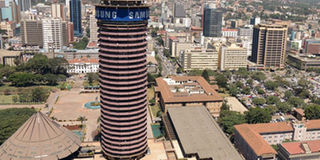Breaking News: At least 10 feared to have drowned in Makueni river
Nairobi City can be a large canvas of literary imagination

A view of Nairobi skyline. Nairobi has its own uniqueness that writers can explore. Steel structures jutting into the sky. Some buildings trying to look taller than they are, like the way we used to stand on our toes as children to look taller. PHOTO | FILE
What you need to know:
- It may not be “deep” but Mochama tries to make sense of the urban maze that is Nairobi. He gives us literature in detached consciousness inspired by the city; its busy streets and byways. He tells the story through the narrator, the Night Runner, a restless, wandering city dweller.
- Nation Twin Towers, in their stark black-and-white, have an industrial stolidity about them… I&M stands out in its sheer, elegant and exuberant beauty”.
Athens is the city of ancient philosophers. Alexandria, the capital of memory. Rome, the city of powerful kings. Jerusalem, the “archetypical diasporic city associated with memory and loss”. From Ezra Pound and T.S Eliot to James Joyce, the city has been central to the postmodernist imagination. Indeed, the city is the striking monument of Western civilisation, the centre of political governance and social chaos.
The dynamism of urban imagery, linking literary expression with a city’s history or reality, needs to be explored both in fiction and non-fiction literature. Charles Dickens couldn’t resist writing about the rise of the industrial city in Hard Times.
About New York City, Christopher Solomon writes, “Oh, I pursued you. We went to the opera, to plays, to gritty little restaurants in Queens. You — the city — were always my date. But you never belonged to me. Eventually you, too, moved on, taking your buzzing neon promise of fame to the next newcomer.” Through these words, Solomon tells of his “love affair” with New York City, the city of dizzying skyscrapers.
Inspiration
Closer home, Nairobi has its own uniqueness that writers can explore. Steel structures jutting into the sky. Some buildings trying to look taller than they are, like the way we used to stand on our toes as children to look taller. An old German adage declares that Stadt Luft macht frei (city air makes men free). Nairobi air should do the same to writers, inspiring them to write about it.
That’s why I was very disappointed with the bashing and utter dismissal in these pages of Nairobi: A Night Guide through the City-in-the-Sun by Tony Mochama. Whether we agree with him or not, he attempted to give us some non-fiction literature about Nairobi (it’s very hard to come by!).
PLACE OF FEAR
It may not be “deep” but Mochama tries to make sense of the urban maze that is Nairobi.
He gives us literature in detached consciousness inspired by the city; its busy streets and byways. He tells the story through the narrator, the Night Runner, a restless, wandering city dweller and an ultimate voyeur of life. It is a book of jagged breaks in thoughts and vicarious experiences thickening and texturing in rugged prose.
The writer tries a difficult task of getting a snapshot of a city that is like a child scampering away because he doesn’t want to appear in a photograph.
The writer is like a photographer trying to capture a glimpse of a fleeting and rapidly-changing Nairobi but before he clicks the camera, the city moves and he captures a rather hazy image of a city in chaos. It is a city of many voices ranging from the urgent to the personal and intense, from the nostalgic to the subtle and to the loud. It is a daunting cityscape. “Nairobi, by weekday dusk, is a mad asylum of matatu mayhem and stone-faced pedestrians, hurrying to get home,” he writes.
However, Mochama’s Nairobi is also enchanting, with “post-card city illusions”. It is like the beautiful but elusive village butterflies we used to chase around as children, in rhapsodic reverence, difficult to pin down.
Mochama writes about Nairobi’s landmark buildings: “The sun scintillates off Lillian Towers, making the building sparkle like bubbles in a champagne glass… Beyond it, the city seems awash with trees so that pink buildings in Parklands, like Stima Plaza, seem to peer like a child’s eyes between fingers out at the city... Nation Twin Towers, in their stark black-and-white, have an industrial stolidity about them… I&M stands out in its sheer, elegant and exuberant beauty”.
However, Nairobi is also a place of fear, a place the Night Runner advises, “Run like a thousand bats out of hell if the occasion calls for it. Muggers would be one such occasion. Masked men would be another”. The city sometimes takes on a dark tinge, with a menacing, snarling side to it.
There are hundreds of books about almost every major Western city, books stunning in their sheer volume and variety. Mochama has done his part in chronicling Nairobi. Other Kenyan writers should do the same or foreigners will do it and misrepresent us as they sometimes do.





